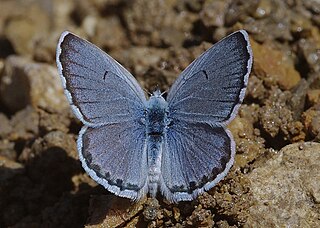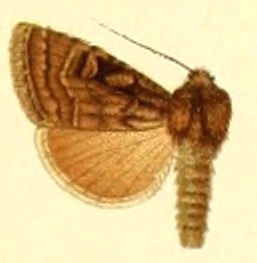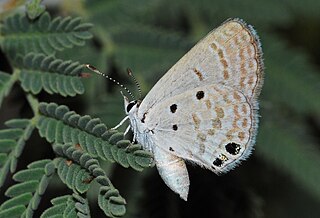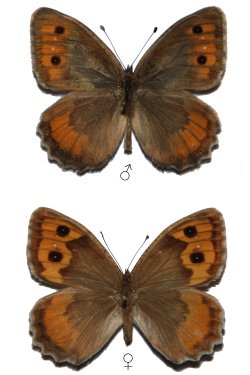
The Köpet Dag, Kopet Dagh, or Koppeh Dagh, also known as the Turkmen-Khorasan Mountain Range, is a mountain range on the border between Turkmenistan and Iran that extends about 650 kilometres (400 mi) along the border southeast of the Caspian Sea, stretching northwest-southeast from near the Caspian Sea in the northwest to the Harirud River in the southeast. In the southwest it borders on the parallel eastern endings of the Alborz mountains being together part of the much larger Alpide belt. The highest peak of the range in Turkmenistan is the Mount Rizeh, located at the southwest of the capital Ashgabat and stands at 2,940 metres (9,646 ft). The highest Iranian summit is Mount Quchan at 3,191 metres (10,469 ft).

The Caucasus-Anatolian-Hyrcanian temperate forests is a composite ecoregion of southern Europe and West Asia, designated by the World Wildlife Fund as one of their Global 200 ecoregions, a list of priority ecoregions for conservation.

Pseudophilotes vicrama, the eastern baton blue, is a small butterfly found in Asia, east to Tian Shan and parts of China, west to the Balkans, Turkey, eastern Europe to southern Finland. It belongs to the lycaenids or blues family. The species was first described by Frederic Moore in 1865.

Tomares is a genus of lycaenid butterflies. They are presently the only genus in the tribe Tomarini. As not all Theclinae have been assigned to tribes, this is preliminary however. The species are found in the Palearctic.
The Turkmen wild goat or bearded goat is a vulnerable sub-species of wild goat native to Iran and Turkmenistan. Turkmen wild goats are present in scattered populations in the central Kopet Dagh along the border between Turkmenistan and Iran between, and in the Large Balkhan (Bolshye) north of Nebit Dagh. It is closely related to domestic goats. As of 1986, their total population was estimated to be 7 000, and decreasing.

Colias aurorina, the Greek clouded butterfly or dawn clouded yellow, is a butterfly in the family Pieridae. It is found in Central Greece, the Near East and the Caucasus area. It is rare in former Yugoslavia.
Haemerosia is a genus of moths of the family Noctuidae. The genus was erected by Jean Baptiste Boisduval in 1840.

Lasiocampa is a genus of moths in the family Lasiocampidae. The genus was described by Franz von Paula Schrank in 1802.

Goniographa marcida is a moth of the family Noctuidae. It is found endemic to the Kopet-Dagh mountain system in Turkmenistan and Iran.

Colias thisoa is a butterfly in the family Pieridae. It is found in the mountains of the Caucasus, Transcaucasia, central Asia, southern Siberia, Turkey and Iran. The habitat consists of humid mountain meadows in the forest belt.

Luthrodes galba, the Persian grass blue, is a butterfly in the family Lycaenidae. It is found in southern Turkey, central and eastern Arabia, Iraq, Iran, Afghanistan, the Caucasus and Cyprus.

Pseudochazara beroe is a species of butterfly in the family Nymphalidae. It is found from western Turkey across southern Transcaucasia and the Elburz Mountains to Kopet-Dagh.

Pseudochazara mniszechii, the tawny rockbrown, is a species of butterfly in the family Nymphalidae. It is confined to Greece, Turkey, northern Iran, Balochistan, and the Caucasus.

Pseudochazara schakuhensis is a species of butterfly in the family Nymphalidae. It is confined to the Alborz and Kopet-Dagh mountains.
Pseudochazara thelephassa, the Baluchi rockbrown, is a species of butterfly in the family Nymphalidae. It is found in Turkey to Asia Minor across Iran, Iraq, Transcaucasia and Kopet-Dagh to Afghanistan and Pakistan.

Pseudochazara panjshira is a species of butterfly in the family Nymphalidae. It is confined to Kopet-Dagh, the Hindu Kush and Alai. The habitat consists of dry stony slopes at altitudes ranging from 1,500 to 3,500 meters.
Schrankia balneorum is a species of moth of the family Erebidae first described by Sergei Alphéraky in 1880. It is found in the Caucasus, Crimea, the southern Urals, Turkey, Georgia, Armenia, Azerbaijan and the Kopet Dagh.

Lacydes spectabilis is a moth of the family Erebidae. It was described by August Michael Tauscher in 1806. It is found in south-eastern Ukraine, eastern European Russia, western Siberia, Kazakhstan, Central Asia, Armenia, eastern Turkey, Turkmenistan, Afghanistan, China (Xinjiang) and southern Mongolia.
Chelis reticulata is a moth in the family Erebidae. It was described by Hugo Theodor Christoph in 1887. It is found in the Caucasus, Transcaucasia, Armenia, the Kopet Dagh, Asia Minor, Syria, northern Lebanon and northern Iran.
Athamanthia phoenicura is a butterfly of the family Lycaenidae. It was described by Julius Lederer in 1870 and is found in Armenia, Turkmenistan, Turkey, Iran, Afghanistan, Pakistan.













